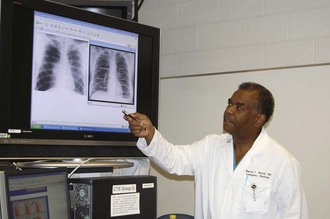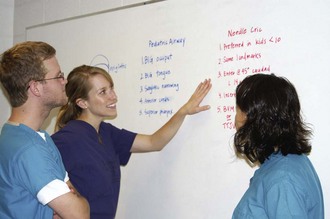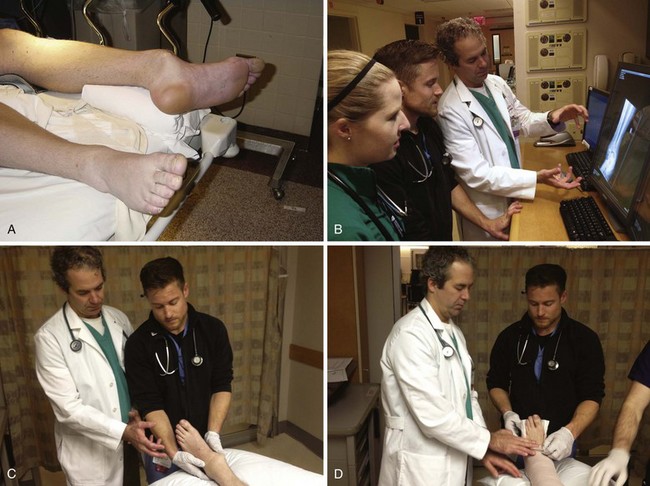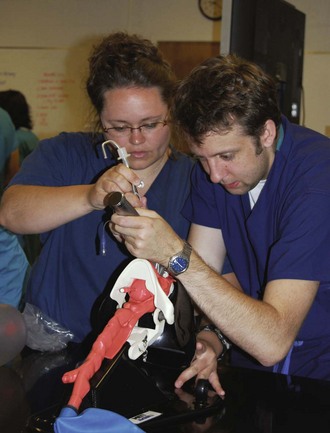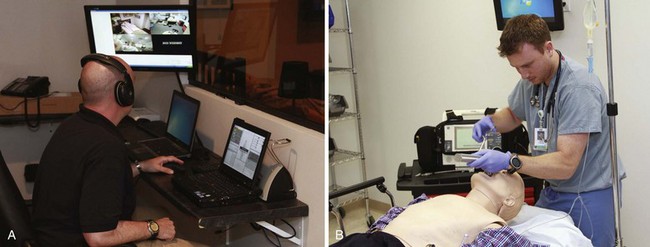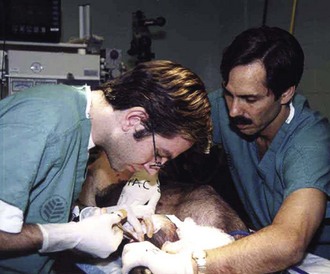Chapter 69 Learning to perform emergency department (ED) procedures is a complex and highly individualized educational process. No longer is the maxim of “see one, do one, teach one” an acceptable educational practice.1 For many emergency medicine (EM) physicians, residency training may be the primary source of instruction on a wide range of common and uncommon procedures.2 A variety of modalities and educational tools exist to aid medical educators in initial training and long-term skill retention. Chapman described a set of eight steps to use as a framework for procedural learning (Box 69-1).3 These steps incorporate the different stages of learning and are important to understand when teaching a procedural skill. This framework is best thought of as a longitudinal approach to teaching procedures over time. It includes focused preparation and memorization before any attempt at performance and progresses to actual practice with repeated feedback and assessment of competency. This outline is closely linked to theories of motor skill acquisition in which learners progress from cognition (understanding the task through explanation and demonstration) to integration (performing the task deliberately and with feedback) and finally to automation (increased speed, efficiency, and precision of the procedure).4 A practical synthesis of these theories for general practice has been described in a four-step process often used to teach procedural skills in a shorter time frame, such as in a simulation session or brief skills course.5 In this approach, an expert teacher demonstrates the skill at regular speed without detailed explanation. Next, the educator performs the procedure slowly and with detailed commentary. Third, the learner verbalizes the skill steps back to the teacher. Finally, the learner performs the procedure, with detailed discussion of each step before performing it. Traditional lecture formats (small or large group) are often used for initial skill teaching (Figs. 69-1 and 69-2). However, there are other methods to introduce a skill concept. Using the four-step method, demonstration and deconstruction could be performed individually by the learner before a teaching session with standard texts, video, or other designated online resource.5,6 Once the learner has progressed to actual practice of the skill, expert assistance and feedback are crucial to progression and mastery and may be the most important feature in some types of skill acquisition.1 Feedback is not only informative but also motivational and should be directed externally (i.e., at the correct motor steps) rather than internally (i.e., at the individual’s particular movements).7 Learner-centered feedback should be delivered by expert tutors who slowly decrease their support as a trainee’s proficiency increases.8 Training at the bedside remains a common and important way to teach residents. Learners should go through formal training in the procedure before attempting it on a live patient. The clinical setting (Fig. 69-3B) should allow adequate time to discuss the procedure in detail. The teacher and learner should review the indications, contraindications, equipment, procedural steps, critical actions, and complications. The resident should be able to verbalize the steps involved in the procedure. This review may be provided either outside the patient’s room or at the bedside, depending on the patient and the clinical scenario. The teacher should observe the learner as she or he performs the procedure and provide guidance and assistance when needed (see Fig. 69-3C). After the procedure, the teacher should examine the patient and assess the adequacy of the procedure, discuss problems that occurred during the procedure, offer suggestions for improvement, and provide a review of postprocedural care (see Fig. 69-3D). The learner should be encouraged to engage the patient while practicing the procedure. In an article on bedside teaching, Monrouxe and colleagues suggested having students explain what they are doing to the patient in lay language because patients like to be involved in teaching so that they can learn more about their condition.9 Explaining the procedure to the patient as it is performed can help consolidate the steps in the learner’s mind and make the patient feel that he or she is an active part of the teaching process. As part of bedside learning, newly deceased patients—those who have not expressly given consent for use of their bodies—have historically been used to practice procedures. In 1994, a survey of program directors of EM and critical care training programs found that 63% of EM programs allow procedures to be performed on newly dead patients.10 Additionally, in a survey involving theoretical clinical scenarios, lay people responded that they would agree to after-death procedures on themselves in 75% of cases and on their relatives in 69% of cases with prior consent. Without prior consent, they would allow such procedures 40% of the time on themselves and 50% on their family members.11 Despite this apparent acceptance of performing invasive procedures on the newly dead by both educators and members of the public, this practice may be limited by certain debated ethical concerns.12–16 There are many alternatives for procedural teaching if bedside teaching on a live, consenting patient is not feasible. Learning on newly deceased patients is not a necessary part of medical education and may, with its attendant ethical pitfalls, be easily avoided without detrimental effect on residents in training. We are now well into the information age, and medical simulation is taking an increasingly important role in medical education. An invaluable teaching tool, medical simulation can be used to improve a learner’s competence and confidence, expose a learner to rare, but potentially lifesaving procedures, and decrease the rate of procedural errors. With a simulator, learners have the opportunity to practice every procedure that they need to know under a variety of different conditions. Modern human patient simulators have been developed or are currently under development for endotracheal intubation, chest compression, electrical cardioversion, cricothyroidotomy, chest tube insertion, pericardiocentesis, diagnostic peritoneal lavage, emergency thoracotomy, lumbar puncture, skin suturing, insertion of peripheral venous and arterial catheters, insertion of central venous lines, and more.17 Many studies have demonstrated the efficacy and applicability of simulation with regard to procedural education.18–20 A panel consisting of members from the Society for Academic Emergency Medicine (SAEM) Simulation Interest Group of the SAEM Technology in Medical Education Committee made the recommendation that “simulation-based training should prioritize procedures infrequently encountered in clinical practice and commonly performed procedures that possess a potential risk to a patient when performed by the less skilled practitioner.” Two main types of simulators are in common use. Procedures can be simulated by using task trainers to teach procedures when available (Fig. 69-4). Each task trainer is a model designed to teach one specific procedure. Models are available for many procedures, including cardiopulmonary resuscitation, peripheral venipuncture, arterial puncture, intraosseous infusion, umbilical vessel catheterization, central line catheterization, lumbar puncture, endotracheal intubation, needle thoracostomy, urinary catheter placement, suturing, and emergency childbirth. They are limited by their inability to perfectly imitate the qualities of human tissue, to simulate force and tactile feedback, and to simulate complications. For example, chest tube task trainers do not bleed when the skin is cut into. High-fidelity simulation is designed to mimic a real-life medical scenario, including the procedures, decision-making skills, and possible permutations that may occur (Fig. 69-5).21 This requires a high-fidelity mannequin, an instructor, a script, a scenario, and a debriefing. The instructor’s responsibility is to create an environment that resembles reality as closely as possible.17 Even though the script is standardized, the software and mannequin can take into account the unpredictable actions of participants, including simulating complications that would occur if certain decisions were made in a real-life scenario. The instructor may redirect participants to take an action that will result in a predetermined response. The debriefing process is also an important learning opportunity in which mistakes can be discussed and alternative courses of action can be explored. In a review of simulation technology, Reznek and associates wrote that to be an effective teaching tool,17 a simulator must provide both educationally sound and realistic feedback to a user’s questions, decisions, and actions. Fresh cadavers are ideal for teaching procedures. To clarify, these are the bodies of individuals who have given consent for their bodies to be used for teaching. The advantage of using a fresh cadaver is that it more clearly resembles the tissue properties and pliability of a live human. The disadvantages are cost, limited availability, and potential risk for transmission of disease.22 Preserved cadavers are also an option if they are more readily available at your institution. A cadaver laboratory offers the advantage of a standardized reproducible laboratory experience under the guidance of an instructor and with no risk to the patient.23 Disadvantages of preserved cadavers are that they do not bleed and they suffer from tissue adherence because of the preservation process, so though excellent for learning the anatomy of procedures, they may not completely simulate the in vivo experience.24 When teaching procedures, long-term skill retention is the goal because decay of procedural skills over time is natural. Information is lost from short-term memory through decay and interference, but fortunately, once committed to long-term memory, it is virtually permanent.25,26 This is analogous to certain learned skills that are retained indefinitely, such as riding a bicycle. These skills are never forgotten because of a process called overlearning. Allowing learners to practice and execute movements actively during learning results in better recall than when they learn from a passive demonstration.27,28 The exact number of times that a trainee must practice a particular skill is unknown, but certain factors have been shown to have an impact on skill retention: quality of the initial instruction, methodology of instruction and testing or evaluation, overlearning, retrieval conditions, length of the interval between training and actual practice, and individual learner and procedure qualities.29 Procedural learning curves are often steep, with novices showing the greatest improvement in skill initially and a plateau effect for more experienced practitioners.29 A study of intubation skills using different task trainers and models found that learners had a success rate of only 50% when performing the skill for the first time on a new trainer but that after 10 to 12 trials on the same trainer, success levels reached a plateau of approximately 80%.30 This same study also found that trainees learned more quickly after successful intubations than after failed ones, and the authors suggested that varying methods of practicing a skill slows learning but leads to increased retention and application to new settings. Limited research has investigated the long-term practical retention of procedural skills. For most ED procedures, which are rarely overlearned, practice is required to maintain these skills.3 Kovacs and colleagues demonstrated that airway management skills decline early after initial training but that performance may be maintained effectively with independent practice and periodic feedback.31 A study of central line insertion found increased competence 3 months after a simulation-based training course, although there was a slight regression from the immediate posttest performance scores.32 Similarly, Boet and coworkers found improved cricothyroidotomy skills at 6 and 12 months after simulator case instruction, although again there was regression from the immediate post-learning scores.33 A chief limitation of these and other similar studies is that longitudinal skill retention is often not measured in actual clinical practice, but on simulators or task trainers, so the long-term effect of specific procedural skill teaching sessions on translation to performance on patients in real clinical situations remains unclear.29 The rate of performance of certain resuscitative procedures in recent years has declined because of several factors. For some procedures, such as ED thoracotomy, critical analyses of patient outcomes after ED thoracotomy have identified narrow conditions for decreased mortality (most notably penetrating trauma to the chest), which has virtually eliminated performing this procedure on victims of blunt trauma.34,35 Chang and associates reported a significant decline in the rate of cricothyroidotomies performed on trauma patients following the beginning of a new EM residency training program.36 They attributed this to several possible causes, including the widespread application of rapid-sequence intubation techniques, the presence of supervisory EM faculty 24 hours a day, and diminished concern regarding orotracheal intubation of patients whose cervical spines have not been radiographically cleared. Competition for procedures between EM residents and those from other specialties has increased; in fact, a survey of EM residency directors found that overall, emergency clinicians perform only 50% of 10 index procedures in the ED.37,38 Previous studies of EM residency trainees have confirmed the thought that certain emergency procedures are performed infrequently during the training years.39–41 A 2008 paper on developing technical expertise in EM procedures via simulation identified several “high-risk, low-frequency” ED procedures: cricothyroidotomy, transvenous cardiac pacing, pericardiocentesis, vaginal delivery, and pediatric resuscitation (medical and trauma).42 They suggested that because the correlation between simulator competence and actual practice ability is unknown, models or simulated scenarios that provide real-life situational learning should be encouraged and studied as bridges to actual practice. Wong and coworkers found that learners who participated in a cricothyroidotomy training session involving the use of video instruction and mannequin practice achieved 96% success rates within 40 seconds by the fifth attempt (with a skill and time plateau for all subsequent attempts).43 Although the exercise was performed on a mannequin, adding a time constraint as part of the metric of success may be indicative of a more realistic situation. An animal procedure laboratory targeted to several uncommon procedures found that learners’ confidence and willingness to perform these skills increased significantly, and use of live animals—though not applicable to all settings—may also enhance the realism of task performance (Fig. 69-6).44
Educational Aspects of Emergency Department Procedures
Concepts in Procedural Skill Training
Formal Education
Procedural Training at the Bedside
Educational Alternatives for Practicing Procedures
Simulation
Task Trainers
High-Fidelity Simulation
Cadaver Laboratories
Long-Term Skill Retention and Uncommon Procedures
Training for Uncommon Procedures
![]()
Stay updated, free articles. Join our Telegram channel

Full access? Get Clinical Tree


Educational Aspects of Emergency Department Procedures

